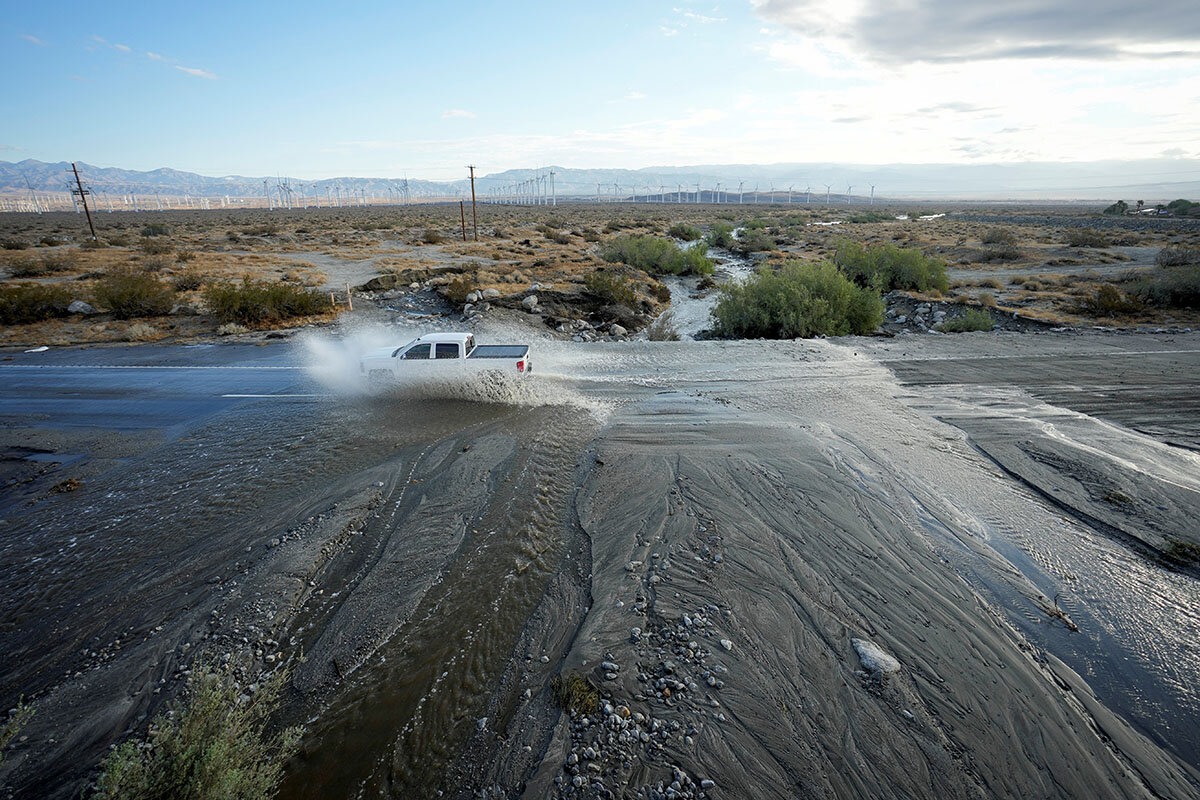Tropical Storm Hilary: Preparation pays off for California
Loading...
| Bakersfield, Calif.
A rare tropical storm moved through California over the weekend, bringing record rainfall, high winds, and mudslides. Despite extreme precipitation and winds of up to 80 mph, catastrophic damage was avoided – in part due to successful preparation efforts honed from years of extreme weather events in the state.
At least 20 million people – more than half of California’s population – were affected by Tropical Storm Hilary, which dropped a year’s worth of rainfall in one day, and in some areas two years’ worth. Hilary made landfall in Mexico on Aug. 20, swept north through Southern California, and then dissipated in southern Nevada. No deaths were reported in the United States; one person died in Mexico.
State, county, and local officials in California quickly mobilized residents and resources, issuing evacuation orders, detailing safety reminders, and providing sandbags ahead of the storm. Efforts were guided by high-tech and highly accurate meteorological predictions, and aided by the storm’s natural dissipation.
Why We Wrote This
California’s familiarity with disaster preparation, born of many experiences with storms, wildfires, and earthquakes, helped ease the impact of rare Tropical Storm Hilary.
“It is a good outcome for a storm of this magnitude,” says Brian Ferguson, deputy director of crisis communications for California’s Office of Emergency Services, who suggests that California’s disaster approach could be modeled elsewhere.
“We have invested a lot in technology and first responders and being on the front foot in disasters,” says Mr. Ferguson. “And I think those are tools that we’ll take for other disasters here in the state, but could also be replicated elsewhere in the country.”
Tropical storms are rare in California. How did Hilary happen?
Tropical Storm Hilary was born of an El Niño warming up waters in the Pacific Ocean, and a heat dome covering the Midwest. The warm water and warm, circulating air intensified the storm – which, at one point, was a Category 4 hurricane – and drew it inland from off the coast of Mexico’s Baja California Peninsula.
“Otherwise, she would have done a normal thing, which is to go across the ocean to our west or maybe turn and go into Mexico and fizzle out there,” explains Alex Tardy, senior meteorologist with the National Weather Service’s San Diego station.
California’s last tropical storm, Nora, was in 1997. Before that was “El Cordonazo” in 1939, which was also the last tropical storm to pass over Los Angeles. Dozens of people died in the 1939 storm.
Hilary arrived during what’s normally the driest month in this drought-sensitive state. The storm’s impact ranged from heavy rain in some areas to wind and mudslides that took out major infrastructure.
How did preparation efforts help mitigate damage?
Californians are used to preparing for disasters. Complex, overlapping events such as drought, fire, rain, snow, and earthquakes are a reality of living here, says Mr. Ferguson. “We even had an earthquake in the middle of this hurricane,” he says. “We don’t have one disaster at a time.”
Meteorological predictions for Hilary, including the storm’s estimated rainfall and path, were on target, giving residents and officials five days to prepare before the storm reached San Diego. State, county, and local emergency management offices coordinated preemptive measures.
Among the actions taken: First responders were mobilized ahead of the storm, with National Guard and swift-water rescue teams, firefighters, road crews, and utility crews sent to areas expected to be impacted. Residents living near burn scars were asked to evacuate. Unhoused people staying in high-risk areas were relocated. Cities gave out free sandbags so residents could protect their homes. California’s two largest school districts closed for a day.
Even with the prep and warnings, the storm stranded a number of people and forced rescues throughout Southern California, especially in rural parts of San Bernardino and Riverside counties east of Los Angeles. And as of Tuesday, an older woman whose home was swept away by a mudslide was still missing.
Nearly 50 people were rescued from flooded streets near Palm Springs in Cathedral City, where the Red Cross was called in to help. And farther south, more than a dozen people were rescued from a homeless encampment in the San Diego River basin.
Experts and officials agree the toll could have been much worse. California’s varied topography results in a steady stream of weather events and related disasters – experiences that “probably made us more prepared to handle an event like this because of the work that’s happened and the public’s understanding of what goes into a disaster and how to keep themselves safe,” Mr. Ferguson says.
How does Hilary fit with other extreme weather in California?
California endured record rain, snowpack, and heat in 2023, after three of the driest years on record. Wildfires have burned about 320,000 acres throughout the state this year, which is less area than the five-year average – but large fires are happening more frequently.
The San Bernardino Mountains, next to the desert resort area of the Coachella Valley, had more snow than ever in late February and early March; July was the hottest month ever recorded in Palm Springs.
During this weekend’s tropical storm, the Coachella Valley, which includes Palm Springs, received the worst storm damage, with rainfall ranging from 3 to 5 inches on the valley floor, and from 8 to 13 inches in the upper mountain headwaters, which drain into the valley. The heavy rain, combined with high winds in the surrounding mountains, caused mudslides that shut down Interstate 10, made rail lines impassable, and damaged homes and other infrastructure.
Hilary may not have a direct link to any one previous extreme weather event, explains meteorologist Mr. Tardy, but collectively, they show a clear trend. “Just the sheer magnitude of these events appears to be hard to argue that it’s not related to the overall warming of the planet,” he says. “We’re taking normal events and making them a little more harsh, a little more extreme, a little more impact.”







